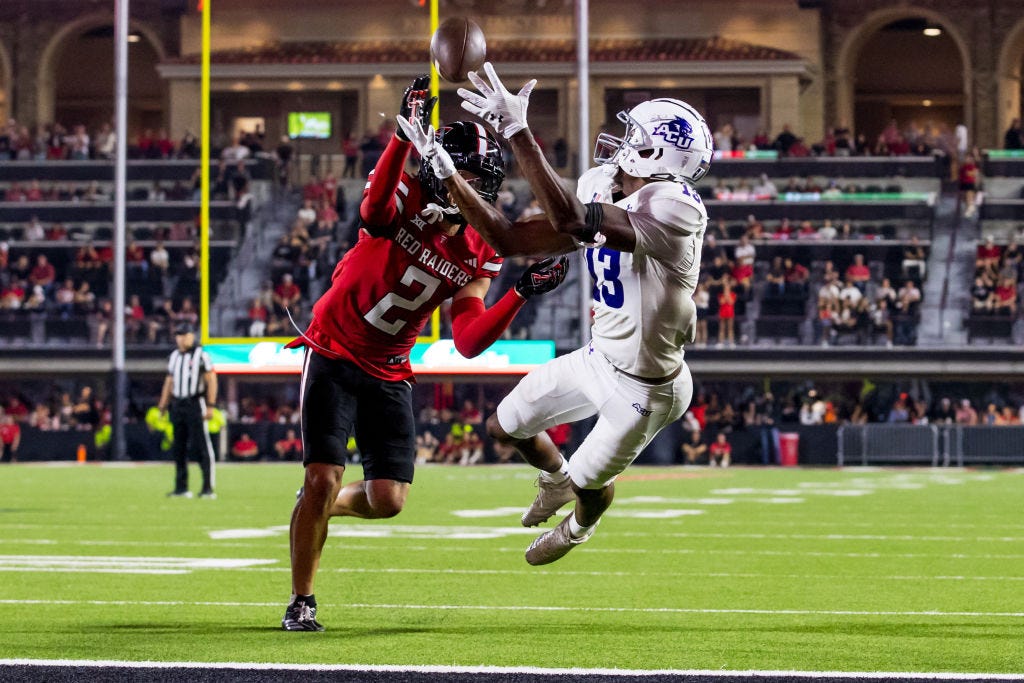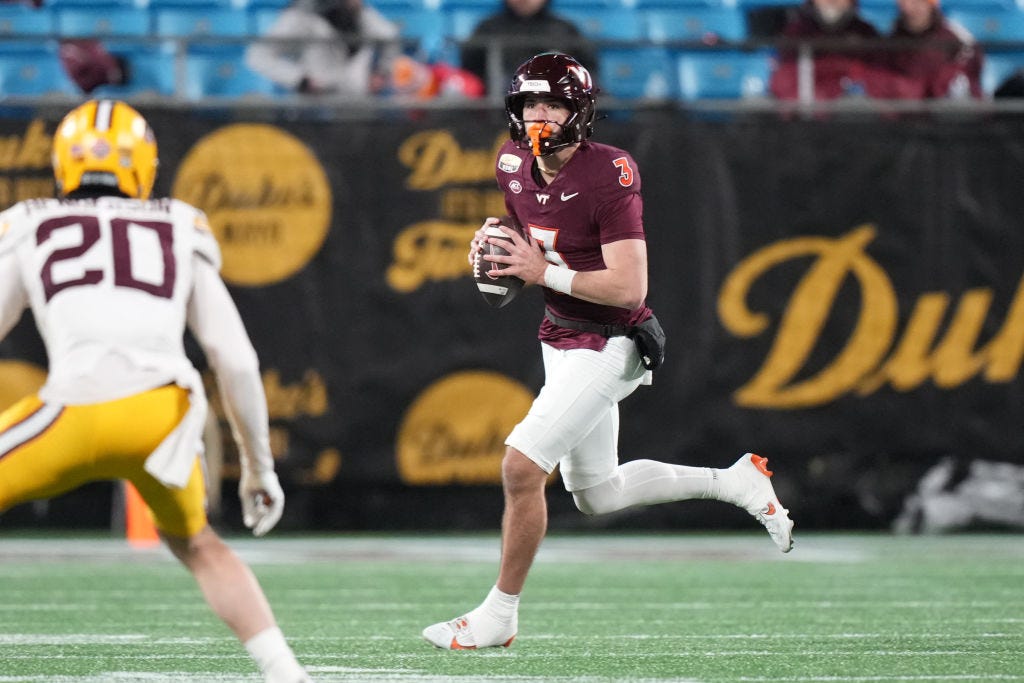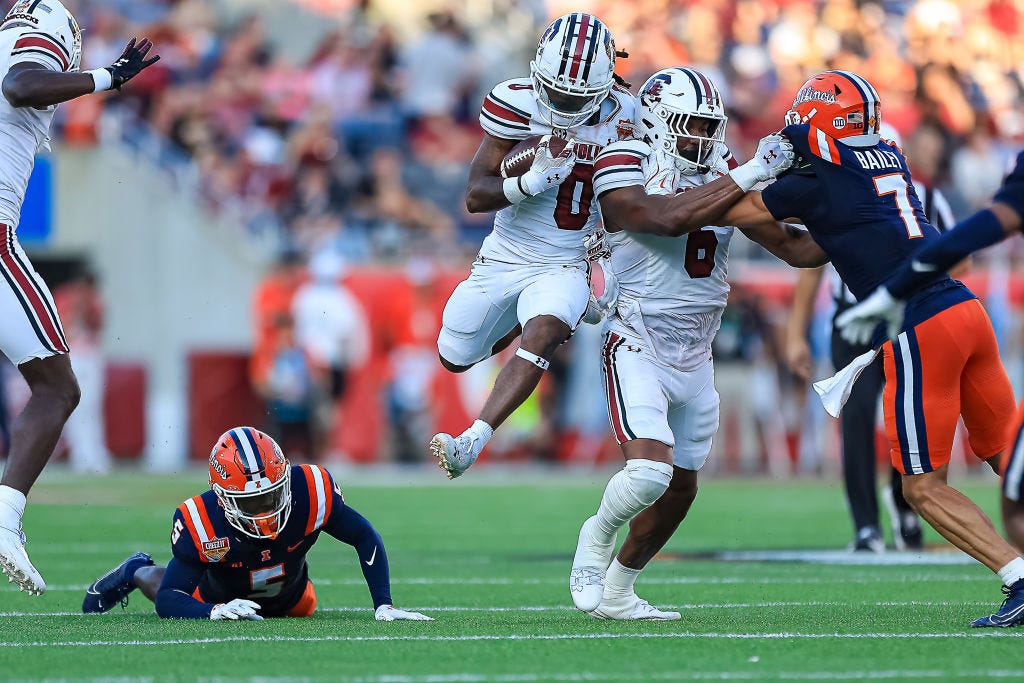Offensive Pro Day Standouts: Which Non-Combine Studs Made Waves at Workouts?
Over 2700 players participated in the pro day process. On offense, we can use athletic modeling to find out who put up the best workouts. Will any succeed?
There is now a defensive version of this post, which you can find here.
Every year, there are “snubs” who do not find themselves invited to the NFL Combine but nevertheless make an impact in the NFL, sometimes even as rookies. Twenty-five or so players in a given year will be drafted without having that combine invite and a good deal more will end up as high-impact undrafted free agents.
Part of the process that identifies them to NFL talent as worthy of selection is the pro day. Most players who fail to earn a combine invite aren’t good prospects and part of the reason they aren’t good prospects is because they lack the elite athletic prowess characteristic of a successful NFL player.
But sometimes players are much more athletic than their invitee counterparts and deserve a second look.
In the past, these players have included Tyreek Hill, Phillip Lindsay, Kobie Turner, Tyler Huntley, Mohamoud Diabate and Poona Ford.
Further back, we can identify players like Adam Thielen, Doug Baldwin, Victor Cruz, Malcom Butler, Julian Edelman, Chris Harris, James Harrison, Fred Jackson, Sam Shields, Osi Umenyiora, Sebastian Vollmer, Wes Welker and Antonio Gates.
While this exercise is good at identifying the types of athletes that could be NFL players, it’s important to note that while some of them weren’t good enough athletes to be considered for the next level, many of them weren’t invited to the NFL Combine because they weren’t perceived as very good players.
That means many of the resumes will be underwhelming – but it’s always possible to be better at the next level than one was in college.
The models used to identify standout players eschews Relative Athletic Score in favor of position-specific models that recognize that the 40-yard dash matters more at cornerback than defensive tackle. We’ll also be looking at players who were explicitly not invited to the NFL Combine, even if they didn’t work out there. A good example of such a player would be Cincinnati’s Luke Kandra, who would have been one of the top-performing guards in this list.
Of the over 2,700 players who participated in pro days this year, which ones stood out on offense?
Quarterback
I haven’t developed a model specifically for the quarterback position as it relates to athleticism, in part because it didn’t seem like it mattered. There’s some research to suggest otherwise but without testing on my part, there isn’t something specific to point to.
In this case, three athletes pop out as having fantastic generalized athleticism.
Tommy Mellott, QB Montana State
Montana State has been a powerhouse in the FCS in recent years, making four semifinal appearances in the last six years, with two appearances in the finals. All but one of their playoff losses in that span of time has been to the eventual FCS champion.
A big part of that winning pedigree has been because of phenom quarterback Tommy Mellott, who took over the starting job during the 2021 playoffs and hasn’t let go since. He was named the FCS player of the year by three different organizations and took home the Walter Payton Award, becoming a unanimous FCS All-American.
Mellott’s workouts are just as impressive. At 200 pounds, Mellott recorded a 4.39-second 40-yard dash (with a blazing 1.50-second 10-yard split), jumped 41 inches in the vertical leap and recorded a 6.93-second three-cone performance.
At under 6’2” however, Mellott is unlikely to sign with an NFL team as a quarterback. Those kind of numbers are difficult to ignore, as is his on-field production. So, Mellott worked out at the Montana State pro day as a receiver, where he would have made this list anyway. As a shorter receiver, the element that matters most are his short shuttle (4.20 seconds) and 20-yard split (est. 2.54 seconds).
He also nearly makes the list at running back, where his ten-yard split and three-cone matter for his size. After leading all FCS quarterbacks in rushing yards with 1,050 (on 8.5 yards per carry), it’s something worth considering.
Donovan Smith, QB Houston
At 6’4”, Donovan Smith carries a much more prototypical quarterback size and likely won’t be asked to play another position. Nevertheless, he’s a high-level athlete with production at both Texas Tech and Houston, where he transferred to after the 2022 season. He lost a quarterback competition to Tyler Shough while his father, the running backs coach for Texas Tech, left the program (DeAndre Smith is now the running backs coach for the Indianapolis Colts).
Because of injuries to Shough, Donovan Smith still played a few games, earning 1,505 in 12 appearances, including four starts. Smith transferred to Houston and started the season, but, in part because of an offseason surgery for a torn labrum, lost that starting job.
Smith’s 4.63-second 40-yard dash is fast for a quarterback, but what really stands out are his impressive jumps – a 37-inch vertical and 10’2” broad jump are almost unheard of for the position. If he can turn this into a developmental opportunity, that could be exciting.
Collin Schlee, QB Virginia Tech
Tabbed as a backup to begin his final year in college, Collin Schlee didn’t see action until a series of injuries to Kyron Drones forced him into the game. After taking over in that Syracuse game and then helming the position at Clemson, he was injured in his third start, going down after a nasty hit forced him into the medical tent and later the locker room.
A two-time transfer – first from Kent State to UCLA, then to Virginia Tech – Schlee likely was hoping to have more than 102 passing attempts in his final two college seasons. If he makes an NFL roster, it could be at a different position than quarterback.
His 4.53-second 40-yard dash is impressive at 211 pounds, but what really stands out is his 39.5-inch vertical and 10’8” broad jump. Throw in an outstanding three-cone of 6.91 seconds and one has the makings of a great wide receiver prospect, at least athletically.
Other Notables: Dante Chachere, Portland State; Demilon Brown, Arkansas-Monticello
Running Back
Running backs are split into two different classes of back in this approach – a “small” running back model meant to capture pass-catching specialists and speedsters below 210 pounds and “large” running backs meant to capture power backs and three-down players.
In essence, this allows us to separate the Dri Archers from the Derrick Henrys.
For smaller backs, three-cone time and ten-yard split speed seem to matter the most. For larger backs, the broad jump and weight-adjusted ten-yard split correlate most strongly with performance.
Weight adjustments can be important; running a 4.37 40-yard dash at 180 pounds is impressive, but it’s far more impressive to do so at 210 pounds. Not only is it more difficult for a player to pull that off, they bring much more force down on an opponent during a collision.
Speaking of weight-adjusting a 40-yard dash, that approach helps project outcomes for both classes of running back. Those that recall Bill Barnwell’s Speed Score probably knew that was coming.
Juju McDowell, RB South Carolina
At 182 pounds, McDowell is evaluated as a smaller back. That’s why his outstanding 1.46-second 10-yard split matters here, as does his very good score of 7.08 seconds in the three-cone drill. His far less impressive 4.50-second 40-yard dash is less important here, but is important context.
South Carolina has been looking for an ideal position to put McDowell for years, and he’s moonlighted as a slot receiver and as a returner along with a role as a backup running back. After Raheim Sanders (a combine invitee who tested as well as McDowell did) transferred in from Arkansas, McDowell’s limited snaps went down even further.
At just 3.8 yards per carry and 366 career receiving yards, McDowell’s production doesn’t recommend him – even when including his 793 career kick return yards – but he’s been in a crowded room for a while. He could stick as a special teams ace somewhere.
Sone Ntoh, RB Monmouth
A 2023 Harvard graduate, Sone Ntoh sought two more years of collegiate play and played as a graduate student at Monmouth College. He was very productive, but FCS players need to dominate and he didn’t quite do that.
Missing out on first- or second-team recognition as an All-FCS player, Ntoh earned honorable mention recognition from the Associated Press as an “all-purpose” player. Unlike many productive FCS backs, however, Ntoh is a bigger back. At 220 pounds, his 4.50-second 40-yard dash is among the best size-adjusted speeds in the pro day set.
More importantly, a ten-yard split of 1.51 seconds at that size speaks to his short-area burst, as does his 10’1” broad jump. While he split time at Monmouth, he didn’t lack for production – with only 109 carries, he led the FCS with 25 rushing touchdowns. Despite his clear goal-line usage, he still managed a respectable yards per carry at 4.5 per tote.
He’s a specialist player at the next level, but he could carve out a respectable niche with the right team.
Keyon Mozee, RB Miami (OH)
Noted as the key to the Miami of Ohio’s offense, Keyon Mozee has been credited for turning around the Redhawks season. After lackluster performances in the first four games of the year, Miami promoted Mozee to lead back and saw their offense flourish, moving from 12.0 points per game in those early showings to 28.9 points per game after that.
Was Mozee’s role responsible for that? That’s probably misleading. After all, three of those first four games were against Power Four opponents and Mozee happened to take over right as Miami entered conference play.
While it’s perhaps meaningful that Miami didn’t give him the starting job immediately, it at least recommends him better than the resumes of a number of other players on this list. At 180 pounds, one might hope to see a speedy 40-yard dash, but at just 4.51 seconds there’s not much top-end speed there. But, a 1.51-second ten-yard split and 6.82-second three-cone give him a great athletic profile to work with.
Other Notables: Woody Marks, USC; Qualan Jones, Stephen F. Austin
Fullback
There’s no real model developed at fullback; instead a model used to correlate with tight end blocking performance was substituted. Generally speaking, athleticism doesn’t track well with this position regardless, but it’s always fun to get a super-athlete like Marcel Reece or Khari Blasingame involved.
Johnny Langan, FB Rutgers
“Johnny Offense” last played football in 2023 but suffered a debilitating injury that prevented him from working out in front of NFL teams in 2024. The quarterback/tight end/fullback/long snapper didn’t sign on with a team last year and reappeared at Rutgers’ pro day with a clean bill of health to work out again.
It was a good decision. Even though his 40-yard dash time of 4.87 seconds didn’t turn any heads, his 9’10” broad jump at 245 pounds speaks well of the lower-body explosion needed to succeed at the position. On top of that, his 1.57-second 10-yard split is well ahead of the average at the position.
With some surprising agility scores, including a 7.08-second three-cone drill, there’s something to be said about the kind of player who might be able to fill any role in an NFL offense.
Miki Suguturaga, TE Utah
Most of the best fullbacks in the modern NFL played other roles in college; Patrick Ricard was a defensive lineman, Kyle Juszczyk, Jakob Johnson and Andrew Beck were tight ends, Keith Smith was a linebacker and C.J. Ham was a halfback.
We’ve seen quarterbacks – Johnny Stanton and Michael Robinson are good examples – and even wide receiver; Marcel Reece was a starting wideout for the Washington Huskies in 2007.
Often, we see more players from other positions than from fullback when it comes to NFL-caliber players. Alec Ingolds and Anthony Shermans are rare. Players considered too short to be tight ends but with the blocking chops are often considered for that role.
Miki Suguturaga may be one such player. He was converted to tight end from edge rusher and played primarily on running downs as a blocker. At 6’3”, he’s not quite “too short to play tight end,” but fullback could be his eventual role.
At 256 pounds, a three-cone time of 7.18 seconds is impressive – as is his broad jump of 10’1” and ten-yard split of 1.59 seconds.
Other notables: Elijah Sohn (TE), Sam Houston State; Amauri Pesek-Hickson (HB), Northern Iowa











